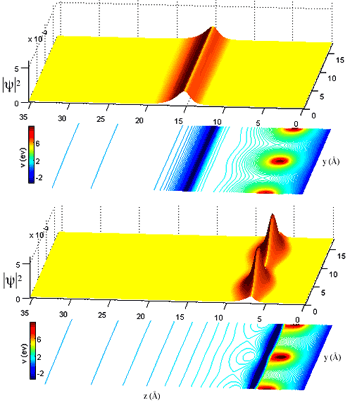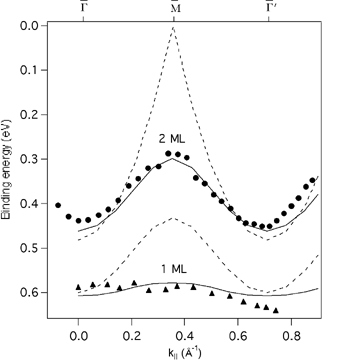

 |
 |
Comp Chem Research Developments | |
| Archive of Comp Chem Research News | |
| April 30, 2003 | |
|
| |
|
Charge redistribution at molecule-solid interfaces is a well known phenomenon is surface chemistry, surface physics, and electronic materials/devices. In organic-based electronic devices, such as organic light-emitting devices (OLED) or field-effect transistors (FET), molecule-metal contacts play critical roles. Can one borrow concepts from silicon electronics to describe charge redistribution at such a molecule-metal interface in terms of band-bending and Schottky barriers? The answer is "no" from a recent paper (J. Chem. Phys. 118, 4337-4340, March 8th, 2003) by graduate students Gregory Dutton and Jingzhi Pu, and Chemistry professors Xiaoyang Zhu and Donald Truhlar. These authors demonstrate that charge redistribution at a molecule-metal interfaces is of substantially localized character. For an ordered molecule-metal interface, C60 on the (111) face of Cu, the interfacial dipoles resulting from charge redistribution effectively form a dipole lattice. The periodic electrostatic potential resulting from such a dipole lattice can provide lateral confinement of interfacial electron wavefunctions, a physical phenomenon which has only been observed in the past for semiconductor quantum well structures. This effect could be used to tune a variety of surface electronic properties, such as the coupling between interfacial states and bulk bands, the lateral transport of charge at the interface, and interfacial electron transfer between two dissimilar materials. This study may have a profound impact not only on surface chemistry and surface physics, but also on the emerging fields of molecular and organic electronics. | |
 |
The potential field (V) and the resulting electron density (|Ψ|2) for the n = 1 image state on Cu(111) covered by 1 (lower) and 2 ML C60 (upper); z is distance from the metal surface and y is lateral distance along thecrystal direction of Cu. |
 |
A comparison of experiments with theory: Parallel dispersions of the n = 1 image state on Cu(111) covered by 1 ML (triangles) and 2 ML C60 (circles) are obtained from angle-resolved two-photon photoemission spectroscopy. k|| is the parallel momentum vector. Dashed curves are theoretical results from a zeroth order model neglecting molecular corrugation and solid curves are from a more realistic model including molecular corrugation. |
|
| |